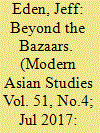|
|
|
Sort Order |
|
|
|
Items / Page
|
|
|
|
|
|
|
| Srl | Item |
| 1 |
ID:
155119


|
|
|
|
|
| Summary/Abstract |
The slave trade in nineteenth-century Central Asia involved hundreds of thousands of slaves, predominantly Persian Shīʿites, and stopping the trade was alleged to be a major motivating factor in the Russian conquest of the region. Nevertheless, Central Asian slavery remains little-studied and little-understood. In this article I will argue, first, that the region's slave trade was characterized by decentralized trade networks and by abundant inter-nomadic trade; and, second, that Russian efforts to end the slave trade by decree and through military force in the 1860s and 70s were not as successful as has often been assumed.
|
|
|
|
|
|
|
|
|
|
|
|
|
|
|
|
| 2 |
ID:
171130


|
|
|
|
|
| Summary/Abstract |
Among the many ‘businesspeople’ whom the promise of commercial success has drawn to southern China in recent years one can find a small number of Kyrgyz middlemen. Working mostly with Russian-speaking clients, their job is to organize buying trips, coordinate with local manufacturers, translate, and oversee cargo shipments. Based on ethnographic fieldwork since 2013, this article examines in detail the careers, work routines and business model adopted by Kyrgyz middlemen in Guangzhou. I argue that in contrast to the early bazaar or shuttle traders, who have been operating across Eurasia since the 1990s, these Kyrgyz middlemen constitute a next kind of economic actor within more diversified, service-oriented and formalized value chains across post-Socialist Eurasia (referred to here as Business 2.0). One of these middlemen’s most salient contributions is to translate between the informal and formal domains of national economies as well as within cross-border economic transactions.
|
|
|
|
|
|
|
|
|
|
|
|
|
|
|
|
| 3 |
ID:
193615


|
|
|
|
|
| Summary/Abstract |
Prison labour was an integral part of the penal order in colonial India in the nineteenth and early twentieth centuries. Especially in Bengal, such coerced labour, overwhelmingly male, was increasingly deployed in handicrafts production rather than in extramural construction projects, a regimen that led to the development of a prison-handicraft complex. Colonial efforts to refine this system focused largely on increasing the severity of the conditions of incarceration and indoor work, but also on the conflicting goal of maximizing the profits of its handiwork. Prisons thus emerged as effective sites of handicrafts production, with the products of their forced labour facilitating the revival of the crafts industry whose growth is generally attributed to the rise of an international arts and crafts movement in Britain and India.
|
|
|
|
|
|
|
|
|
|
|
|
|
|
|
|
| 4 |
ID:
171124


|
|
|
|
|
| Summary/Abstract |
Cross-border trade is central to the socio-economic structure of the former Soviet republics and their integration in the world economy. In the Caucasus and Central Asia, bazaars have functioned as nodes that enable multi-directional, cross-border trade. While there have been studies on the bazaar trade in the Soviet successor states, few have used quantitative methods. Drawing from 600 structured interviews with traders in Dordoi (Bishkek) and Lilo (Tbilisi), the data from Dordoi highlight the relationship between informality and entrepreneurship, unlike Lilo, where there are clearer markers of formality, but where bazaar trade also seems to be less profitable. The data from the 600 interviews illustrate that Dordoi functions as a globalized trading hub, its transnational linkages forged by the bazaar traders and the buyers themselves. By contrast, trade in Lilo is more localized. Hence, ‘globalization from below’ presents itself differently across the post-Soviet space.
|
|
|
|
|
|
|
|
|
|
|
|
|
|
|
|
|
|
|
|
|